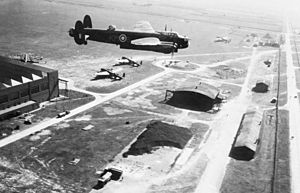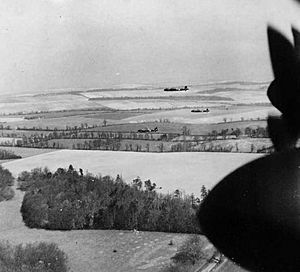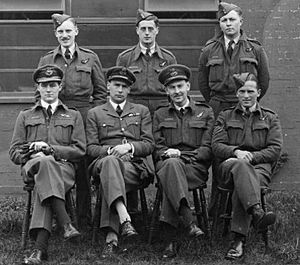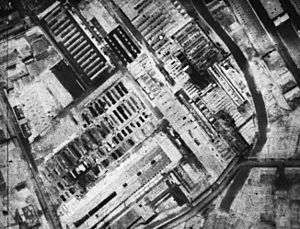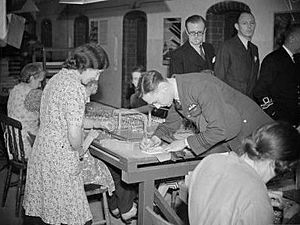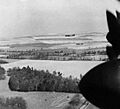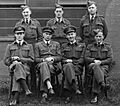Augsburg raid facts for kids
Quick facts for kids Operation Margin |
|||||
|---|---|---|---|---|---|
| Part of Second World War | |||||
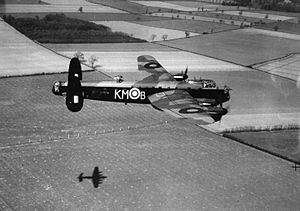 Nettleton over England on his final practice run for the Augsburg raid |
|||||
|
|||||
| Belligerents | |||||
| Commanders and leaders | |||||
| Sq. Ldr. John D. Nettleton | |||||
| Strength | |||||
| 12 Lancaster bombers | |||||
| Casualties and losses | |||||
| 7 aircraft shot down, 5 badly damaged |
|||||
| No significant damage inflicted upon the MAN U-boat engine plant. | |||||
The Augsburg Raid, also called Operation Margin, was a special bombing mission by the RAF during the Second World War. It happened on April 17, 1942, in Augsburg, Germany. The target was a factory that made engines for German U-boats (submarines). This mission was given to No. 44 (Rhodesia) Squadron and No. 97 Squadron. Both squadrons used the new Avro Lancaster bomber. This plane was fast and could carry many bombs, which made the RAF hopeful for success. It was one of the first attacks on German industry in Augsburg.
Contents
Why Was This Raid Important?
For Arthur Harris, the leader of RAF Bomber Command, the Augsburg raid was a big risk. He had just taken command and needed to show that his bombers could be effective. For two years, Bomber Command had been attacking German factories at night, but with little success and many losses.
Harris wanted to help fight German U-boats, which were sinking many ships. He believed that attacking the factory that built U-boat engines would be a good way to do this. The Maschinenfabrik Augsburg-Nürnberg (MAN) factory made half of all U-boat engines. Destroying it would greatly slow down U-boat production.
What Made the Target Difficult?
The MAN factory was a small target. Bomber Command's night raids were not very accurate. To damage this factory, bombers needed to be very precise. Also, the factory was in southern Germany, nearly 600 miles away. This meant flying a long distance over enemy territory.
The Avro Lancaster bomber was still new and unknown to the Germans. This mission would be its first big test. It was an experimental raid designed to use the Lancaster's speed, range, and bomb-carrying ability.
How Was the Raid Planned?
The planners hoped a daylight raid would allow for accurate bombing. They also thought flying very low would help the planes avoid German radar and surprise the enemy. Seven Lancasters from No. 44 Squadron and seven from No. 97 Squadron practiced long, low-level flights. They did mock raids on Inverness, Scotland, to get ready.
German fighter planes were mostly based in northern France, Belgium, and Germany. British fighter escorts could only protect the bombers for the first 200 miles. After that, the bombers would be on their own. To help the Lancasters get through, Fighter Command planned a large distraction.
What Was the Diversion?
About 30 Douglas Boston bombers, with many fighter escorts, would attack other targets. One group would attack the port at Cherbourg. Another group would attack the shipyard at Rouen. Other large operations would happen further north. These attacks were meant to draw German fighters away from the Lancasters' path. The Lancasters would fly very low to avoid radar detection all the way to their target.
The bomber force came from the two squadrons that had the new Lancaster planes. Squadron Leader John Nettleton of 44 Squadron led the raid. He was an experienced pilot from South Africa. Squadron Leader John Sherwood led 97 Squadron.
Bomber Command crews usually flew alone at high altitude at night. They were not used to flying low or in close formation. But for this mission, they needed to fly together for better defense. A week before the raid, the two squadrons trained in low-level formation flying. Each squadron prepared seven Lancaster crews, but only six planes would go on the mission.
For the mission, each squadron would fly in two groups of three planes. Each Lancaster would carry four 1,000-pound high explosive bombs. The bombs were set to explode 11 seconds after being dropped. This gave the planes time to get away from the target area. This was the first raid over enemy territory for the Lancaster.
The Raid Begins
On April 17, 1942, 14 Lancasters were ready for the mission. Their fuel tanks were full, and they carried their bombs. The crews were told the details of the mission. They would fly over 500 miles beyond the French coast in daylight. The target was a single building, about the size of a football field. Many crews found this hard to believe.
Seven Lancasters from 44 Squadron took off from RAF Waddington. Nettleton's force flew south. Ten miles east, seven more Lancasters from 97 Squadron took off from RAF Woodhall Spa. The sky was clear and warm. The 14 planes flew to Selsey Bill, a navigation point on the English coast. There, the extra Lancasters turned back.
The remaining planes flew on. As they crossed the coast, they turned sharply left and dropped to 50 feet to cross the English Channel. Nettleton's group was slightly ahead. They reached the French coast near Dives sur Mer. The diversionary attacks were already happening. Flying under German radar, the 12 planes moved inland without being noticed at first.
Facing German Fighters
Nettleton's group flew over Lisieux, where they faced anti-aircraft fire. Some planes were hit, but not badly. Sherwood's group flew a bit further south. As 44 Squadron approached Evreux, they passed near a German airfield. German fighters were returning to base after fighting the diversionary bombers. Suddenly, several German fighters turned towards the Lancasters.
The German fighters chased the bombers. The Germans had never seen the four-engine Lancasters before. The Lancasters fired back with their eight machine guns. The German pilots soon realized the Lancaster's guns were only .303 caliber. They began to attack more aggressively.
Warrant Officer Crum's Lancaster was hit first. Bullets shattered the cockpit window. Crum and his navigator were hit by plastic shards. Crum's face was bleeding, but he kept flying. Warrant Officer Beckett's plane was hit in the wing and burst into flames. It crashed into trees and broke apart.
Crum's Lancaster was attacked again. His gunners were wounded. Then a fuel tank in the wing caught fire. Crum, half-blinded by blood, managed to land the damaged plane in a wheat field. The crew got out quickly, expecting it to explode. The fire went out. Crum then set the plane on fire to keep it from falling into German hands. He and his crew tried to escape but were caught and became prisoners of war.
Flight Lieutenant Sandford's plane was also attacked. He tried to fly under some power lines to escape. His wing hit the ground, and the plane crashed and exploded. Everyone on board died.
Now, the German fighters attacked the lead group of planes. Warrant Officer "Dusty" Rhodes's Lancaster was hit by a famous German fighter pilot, Walter Oesau. Rhodes's plane caught fire and crashed. This was Oesau's 101st victory.
Only Nettleton and Garwell's planes were left from the first group. Both had been hit many times. Then, the German fighters suddenly broke off their attacks and flew away. This allowed the two Lancasters to escape. Nettleton's group then faced heavy anti-aircraft fire over a German supply depot. Luckily, both planes got through without more damage.
Reaching the Target
Meanwhile, Sherwood's group of six Lancasters from 97 Squadron had flown unnoticed. Both groups continued south separately. They passed west of Paris and then turned east. They flew over Sens and then southeast towards the Swiss border. They reached Lake Constance and then turned northeast towards Munich. They flew over Ammersee lake and then turned north, finally seeing their target: Augsburg.
Their arrival in Augsburg was noticed. Nettleton's two planes arrived first, flying low over the rooftops. They faced intense and accurate anti-aircraft fire. Despite the close-range fire, they held their course and dropped their bombs on the factory. As they pulled away, Garwell's plane was hit in a fuel tank and caught fire. Garwell crash-landed. Three of his crew died, but he and three others survived.
Shortly after Nettleton's planes left, Sherwood's two groups of three arrived. They had flown nearly 600 miles at very low level and arrived exactly on time. The factory was already smoking from the first attack. They flew in at rooftop level, dropped their bombs, and then flew even lower to escape the anti-aircraft fire. Sherwood's plane was hit and caught fire. He kept leading his section away, even with one wing burning. Then, his plane became uncontrollable, crashed, and exploded.
In the second group, all three pilots saw Sherwood go down. Warrant Officer Mycock's plane was hit and caught fire, but he bravely continued and dropped his bombs on the target before his plane exploded, killing everyone. Flying Officer Deverill's plane was also hit and caught fire. He also dropped his bombs on the target. His crew managed to control the fire, but his plane had a large gash in its side. He managed to fly with another 97 Squadron plane as darkness fell, and they returned to base together.
The 97 Squadron planes made it back to Woodhall Spa before Nettleton reached Waddington. Nettleton's plane was badly damaged. He finally broke radio silence to ask for navigation help and learned they had flown over the Irish Sea. They turned around and landed at Squire's Gate aerodrome. Nettleton called Waddington to report. Only five planes had made it back. Out of 85 crew members who started, 49 were missing.
What Happened After?
The raid had heavy losses. Four Lancasters from 44 Squadron were shot down over France. Another was lost over the target. Two more from 97 Squadron were lost to anti-aircraft fire in Augsburg. Only five planes returned, a 58% loss rate. One of the returning planes was too damaged to be repaired. The surviving crews were very sad about the losses. They were given three days off to recover. Nettleton then worked with his crew to figure out new ways to avoid enemy fighters.
Prime Minister Winston Churchill praised the raid. He called it an "outstanding achievement" and thanked the airmen. Harris recommended both Nettleton and Sherwood for the Victoria Cross, a very high award for bravery. Nettleton received the award on April 24, 1942. He was the first South African in the war to win the Victoria Cross.
The Air Ministry did not give Sherwood the Victoria Cross at first. But it turned out he had survived the crash! When his plane hit the ground, his pilot seat broke off and was thrown clear. Sherwood was still strapped in and was the only survivor from his plane. Many other surviving airmen also received awards.
The British government used the raid to boost public morale. The surviving crews were asked to speak about their experiences. Nettleton felt responsible for the lost crews, but he did what the government asked.
Even though the MAN factory was hit, it continued to produce U-boat engines. The crews thought they had destroyed the target. They had dropped 17 bombs on the main tool shop, causing damage to the roof and walls. But most of the machines inside were still working. Only 12 of the 17 bombs exploded.
The Augsburg mission was the longest low-level attack of the Second World War. However, losing 58% of the planes was too high. This showed that daylight attacks on well-defended targets were still too dangerous in 1942. The raid's outcome pushed Bomber Command to create the Target Finding Force. This force would find targets for other bombers. Bomber Command still tried occasional daylight raids on small, important targets.
Aviation historian Robert Owen called the Augsburg Raid one of the bravest raids ever. He sees it as a great example of courage, skill, and determination from Bomber Command.
Images for kids


